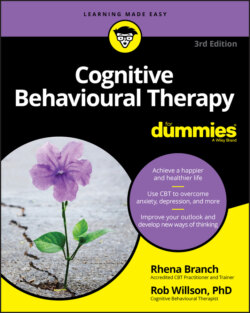Читать книгу Cognitive Behavioural Therapy For Dummies - Rob Willson - Страница 49
Seeking Evidence to See Which Theory Best Fits the Facts
ОглавлениеThe scientific principle known as Occam’s razor states that all things considered, the simplest theory is usually the best. Whichever theory explains a phenomenon most simply is the one a scientist adopts. When you want to test out a theory or idea you hold about yourself, others or the world, developing an alternative theory is a good idea. This gives you the chance to disprove your original theory and to endorse the healthier alternative.
Some emotional problems don’t respond well to attempts to disprove a negative prediction. In such cases, you may be better off developing some competing theories about what the problem actually is. You then devise experiments to gather more evidence and see which theory reflects reality most accurately.
For example, imagine that your boss never says a cheerful ‘good morning’ to you. You develop the following two theories:
Theory A: ‘My boss doesn’t like me at all’.
Theory B: ‘My boss isn’t friendly in the mornings and is a bit rude, but he’s like this to a lot of employees, not just me’.
You’re now in a position to gather evidence for whether theory A or B best explains the phenomenon of your boss failing to be cheerful towards you in the mornings.
A theory is just an idea or assumption that you hold, which, to your mind, explains why something happens – a seriously technical word for a simple concept.
Often, developing one additional theory to compete with your original theory is enough. However, you can develop more alternative theories if you think they may help you get to the bottom of what you’re experiencing. Taking the previous example, you may have a third theory, such as ‘My boss is cheerful only with employees that he knows very well’, or even a fourth theory, such as ‘My boss is cheerful only with employees of the same rank or above him’.
Developing competing theories can be particularly helpful in the following situations:
Dealing with predictions that may be months or years away from being proven: If you fear you’ll go to hell for having an intrusive thought about causing harm to someone, then this outcome is likely to be sometime away. Similarly, if you have illness anxiety and spend hours each day preoccupied with the idea that physical sensations in your body may be signs that you’ll become ill and die, you’re unlikely to know straightaway whether this will actually happen. With these kinds of catastrophic thought, you need to design experiments to help you gather evidence that supports the theory that you have a worry or anxiety problem, rather than a damnation ticket or a terminal illness.
Dealing with beliefs that are impossible to prove or disprove conclusively: Perhaps you’re anxious about others having negative opinions of you. You cannot know for sure what other people think, but even if someone tells you that your fears are unfounded, you can never know with absolute certainty what he’s thinking. Similarly, if you have jealous thoughts that your partner desires someone else, but he reassures you otherwise, you may remain uncertain of his true feelings.
For both of these situations, you can employ the theory A or theory B strategy:
Design an experiment to gather evidence to support the idea that your jealous feelings are based on your jealous thoughts (theory B), rather than on reality (theory A).
Similarly, devise an experiment to test out whether your original theory A, that ‘People don’t like me’, or alternative theory B, that ‘I often think that people don’t like me because I’m so worried about others’ opinions of me that I end up seeing a lot of their behaviour as signs of dislike’, best explains your experiences in social situations.
Here is an example of how Alex used the competing theories approach to get a better understanding of his physical sensations. Originally, Alex assumed his theory that uncomfortable bodily sensations signalled the onset of a heart attack was correct. By testing this in practice, Alex was able to consider that an alternative theory – uncomfortable bodily sensations are a by-product of anxiety – may be more accurate.
Describe the problem. Alex suffers from panic attacks. He feels hot and his heart races, sometimes out of the blue. When he feels these sensations, he fears he’s having a heart attack. Alex sits down to try to reduce the strain on his heart (an example of a safety behaviour). He goes out of his way to avoid situations in which he has experienced these symptoms.
Develop competing theories. Alex devises two theories about his raised heart rate:Theory A: ‘My heart beating quickly means I’m vulnerable to having a heart attack’.Theory B: ‘My heart beating quickly is a consequence of anxiety’.
Execute an experiment. Alex decides to deliberately confront situations that tend to trigger his raised heart rate and to stay in them, without sitting down, until his anxiety reduces. He predicts that if theory B is correct, then his heart rate will reduce after his anxiety subsides and he can leave the situation without having come to any harm.
Examine the results. Alex finds that his heart rate does indeed reduce when he stays with his anxiety. He’s struck by what a difference this knowledge makes to his confidence and the realisation that he’s not going to come to any harm from his raised heart rate when he resists the urge to sit down. He concludes that he can reasonably have about 70 per cent confidence in his new theory that his raised heart rate is a benign consequence of anxiety.
You can’t always prove conclusively that something isn’t so. However, you can experiment to see whether certain emotional states, and mental or behavioural activities, have a beneficial or detrimental effect on the kinds of thoughts that play on your mind.
